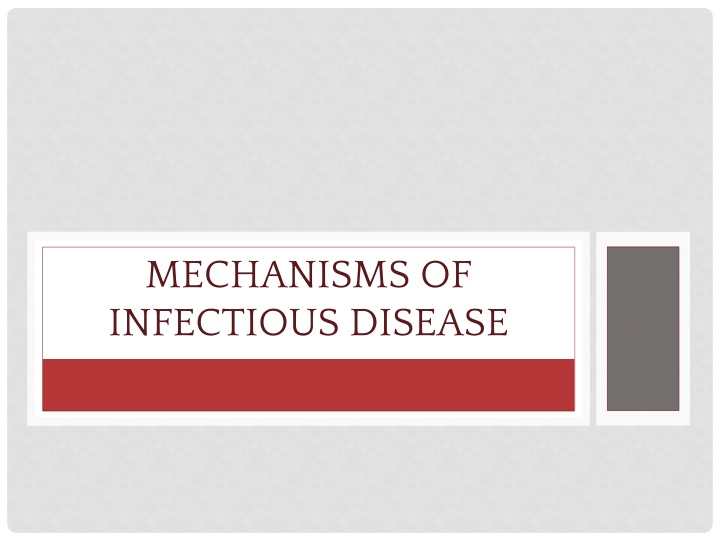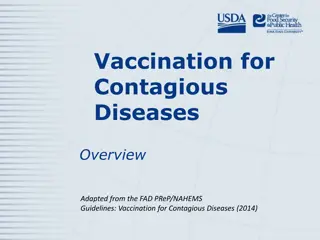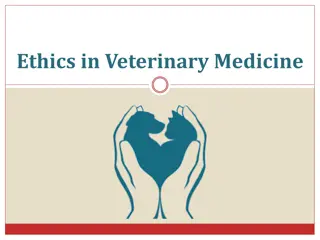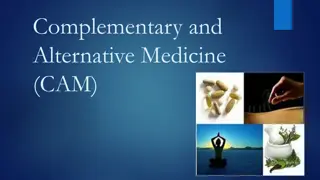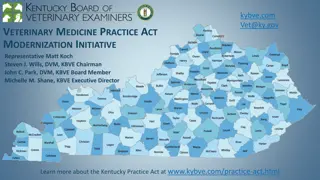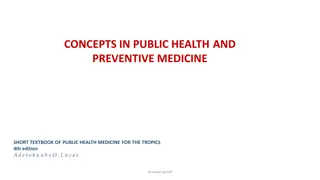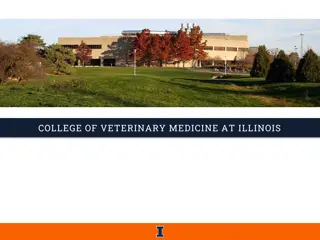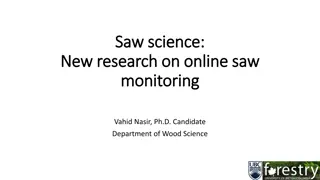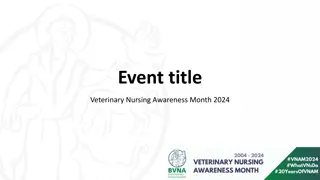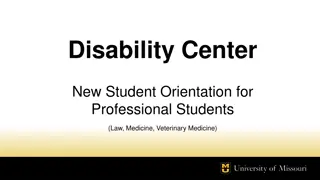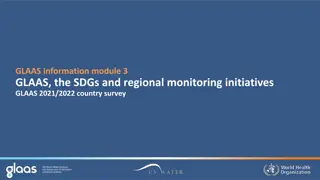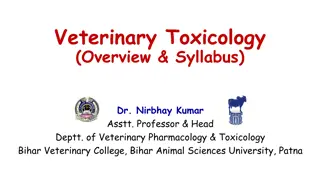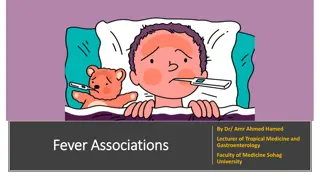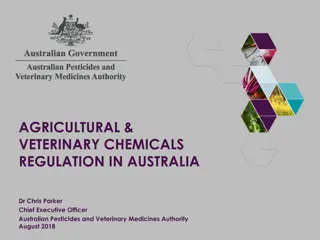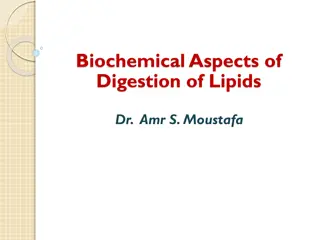AMR Monitoring in Veterinary Medicine Industry Initiatives
In the Veterinary Medicine industry, AMR monitoring plays a crucial role in identifying antibiotic resistance. Dr. Shabbir Simjee, a renowned microbiologist at Elanco Animal Health, has contributed significantly to this field through various initiatives and global surveillance programs. The importance of harmonization in surveillance programs to ensure data quality and uniform interpretation is highlighted, along with guidelines for sampling strategies, antimicrobial testing, and data analysis. Dr. Simjee's expertise and achievements in this area underscore the ongoing efforts towards combating antimicrobial resistance in veterinary medicine.
Download Presentation

Please find below an Image/Link to download the presentation.
The content on the website is provided AS IS for your information and personal use only. It may not be sold, licensed, or shared on other websites without obtaining consent from the author.If you encounter any issues during the download, it is possible that the publisher has removed the file from their server.
You are allowed to download the files provided on this website for personal or commercial use, subject to the condition that they are used lawfully. All files are the property of their respective owners.
The content on the website is provided AS IS for your information and personal use only. It may not be sold, licensed, or shared on other websites without obtaining consent from the author.
E N D
Presentation Transcript
MECHANISMS OF INFECTIOUS DISEASE
TERMINOLOGY INVOLVED IN THE STUDY OF INFECTIOUS DISEASE Host any organism capable of supporting the nutritional and physical growth requirements of another organism Infectious disease the disease state brought about by the interaction with another organism Colonization the presence and multiplication of a living organism on or within the host Microflora normal, harmless bacteria inhabiting exposed surfaces of the body Virulence the disease-inducing potential
TERMINOLOGY INVOLVED IN THE STUDY OF INFECTIOUS DISEASE (CONT.) Pathogens microorganisms so virulent that they are rarely found in the absence of disease Saprophytes free-living organisms obtaining their growth from dead or decaying organic material from the environment
TERMINOLOGY INVOLVED IN THE STUDY OF INFECTIOUS DISEASE (CONT.) Mutualism: an interaction in which the microorganism and the host both derive benefits from the interaction Commensalism: an interaction in which colonizing bacteria acquire nutritional needs and shelter but the host body not affected Parasitic relationship: only the infecting organism benefits from the relationship If the host sustains injury or pathologic damage, the process is called an infectious disease.
AGENTS OF INFECTIOUS DISEASE Prions Viruses Bacteria Rickettsiaceae Chlamydiaceae Fungi Parasites
VIRUSES Smallest pathogens Have no organized cellular structure Consist of a protein coat surrounding a nucleic acid core of DNA or RNA Are incapable of replication outside a living cell
MICROORGANISMS Eukaryotes (Fungi) Contain a membrane-bound nucleus Prokaryotes (Bacteria) Nucleus is not separated Exotoxins are virulent proteins released from bacterial cells during growth
CLASSIFICATION OF BACTERIA According to the microscopic appearance According to staining of the cell Gram-positive organisms: stained purple by a primary basic dye (usually crystal violet) Gram-negative organisms: not stained by the crystal violet but are counterstained red by a second dye (safranin)
PARASITES Types Protozoa-Example of protozoal infections include Malaria and Giardiasis Helminths-Wormlike parasites producing diseases such as trichinosis Arthropods-vectors (e.g., ticks) of infectious diseases Method of Infecting These members of the animal kingdom infect and cause diseases in other animals. These animals then transmit disease to humans.
RICKETTSIACEAE, ANAPLASMATACEAE, CHLAMYDIACEAE, COXIELLA Organisms that combine the characteristics of viral and bacterial agents to produce disease in humans Are obligate intracellular pathogens like the viruses Produce a rigid peptidoglycan cell wall Reproduce asexually by cellular division Contain RNA and DNA similar to the bacteria
CLASSIFICATION OF INFECTIOUS DISEASE Incidence Portal of entry Source Symptoms Disease course Site of infection Virulence factors
EPIDEMIOLOGY (TERMINOLOGY) Epidemiology: the study of factors, events, and circumstances that influence the transmission of infectious diseases among humans Incidence: the number of new cases of an infectious disease that occur within a defined population Prevalence: the number of active cases at any given time
INCIDENCE OF DISEASE Endemic disease: found in a particular geographic region The incidence and prevalence are expected and relatively stable Epidemic: Abrupt and unexpected increase in the incidence of disease over endemic rates Pandemic: Spread of disease beyond continental boundaries
PORTALS OF ENTRY Penetration Direct contact Ingestion Inhalation
SOURCE OF AN INFECTIOUS DISEASE Location Nosocomial: develop in hospitalized patients Community acquired: acquired outside of health care facilities Host An object or substance from which the infectious agent was acquired May be endogenous or exogenous
SYMPTOMATOLOGY Specific: reflects the site of infection (e.g., diarrhea, rash, convulsions, hemorrhage, pneumonia) Nonspecific: can be shared by a number of diverse infectious diseases (e.g., symptoms such as fever, myalgia, headache) Obvious: predictable patterns (e.g., chickenpox and measles) Covert: may require laboratory testing to detect (e.g., hepatitis or increased white blood cell count)
DISEASE COURSE IN INFECTION Incubation period Prodromal stage Acute stage Convalescent stage Resolution stage
FACTORS INFLUENCING THE SITE OF AN INFECTIOUS DISEASE Type of pathogen Portal of entry Competence of the host s immunologic defense system
TYPES OF ANTIMICROBIAL AGENTS Antibacterial agents Antiviral agents Antifungal agents Antiparasitic agents
DRUG RESISTANCE Bacterial resistance mechanisms Antiviral resistance mechanisms Inactivate antibiotics Nucleoloside analogs Genetically alter antibiotic binding sites Protease inhibitors Need for combination or alternating therapy with multiple antiretroviral agents Bypass antibiotic activity Changes in the bacterial cell wall
INTRAVENOUS IMMUNOGLOBULIN (IMMUNOTHERAPY) AND CYTOKINE THERAPY Supplementing or stimulating the host s immune response so that the spread of a pathogen is limited or reversed is done by immunotherapy, typically through the use of intravenous immunoglobulin Pathogen-specific antibodies given to the patient as an infusion to facilitate neutralization, phagocytosis, and clearance of infectious agents above and beyond the capabilities of the diseased host
CRITERIA FOR DIAGNOSIS OF AN INFECTIOUS DISEASE The recovery of a probable pathogen or evidence of its presence from the infected sites of a diseased host Accurate documentation of clinical signs and symptoms (symptomatology) compatible with an infectious process
TECHNIQUES FOR LABORATORY DIAGNOSIS OF AN INFECTIOUS AGENT Culture Serology or detection of characteristic antigens Genomic sequences or metabolites produced by the pathogen
CATEGORIES OF VIRULENCE FACTORS Toxins Exotoxins-proteins released from bacterial cell during growth Endotoxins-lipids and polysaccharides found in the cell wall of bacteria (not released from bacteria during growth) Adhesion factors Evasive factors Invasive factors
NONPHARMACOLOGICAL INTERVENTION Surgical interventions Providing access to an infected site by antimicrobial agents (drainage of an abscess) Cleaning of the site (debridement) Removing infected organs or tissue (e.g., appendectomy)
ANTIBIOTIC MECHANISMS Interference with a specific step in bacterial cell wall synthesis Inhibition of bacterial protein synthesis Interruption of bacterial nucleic acid synthesis Interference with normal bacterial metabolism
CLASSIFICATION OF ANTIBIOTIC ACTION Bactericidal if it causes irreversible and lethal damage to the bacterial pathogen Bacteriostatic if its inhibitory effects on bacterial growth are reversed when the agent is eliminated
CLASSIFICATION AND TARGET SITE OF ANTIBACTERIAL AGENTS Penicillins: cell wall Cephalosporins: cell wall Monobactams: cell wall Aminoglycosides: ribosomes Tetracyclines: ribosomes Macrolides: ribosomes Sulfonamides: folic acid synthesis Glycopeptides: ribosomes Quinolones: DNA synthesis
WEAPONS OF BIOTERRORISM Category A Agents Plague Tularemia Smallpox Hemorrhagic fever viruses Category B Agents Agents of food-borne and water-borne diseases Agents of zoonotic infections
WEAPONS OF BIOTERRORISM (CONT.) Category B Agents (cont.) Viral encephalitides Toxins from castor bean Category C Agents Mycobacterium tuberculosis Nipah virus and hantavirus Tick-borne and Yellow fever viruses Cryptosporidium parvum
